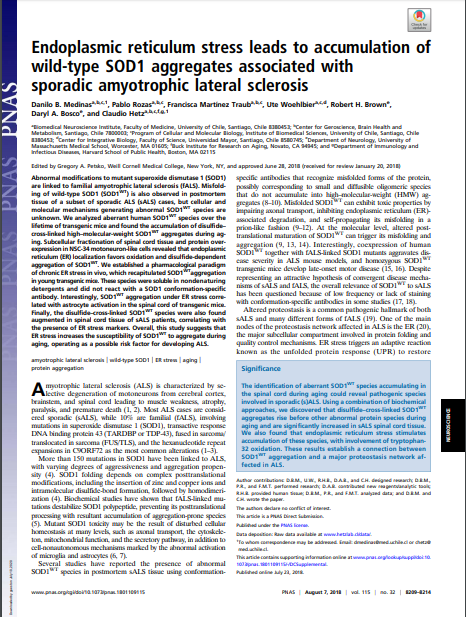Endoplasmic reticulum stress leads to accumulation of wild-type SOD1 aggregates associated with sporadic amyotrophic lateral sclerosis

Fecha
2018Autor
Woehlbier, Ute [Univ Mayor, Ctr Integrat Biol, Fac Sci, Santiago, Chile]
Medinas, Danilo B.
Rozas, Pablo
Martínez Traub, Francisca
Brown, Robert H.
Bosco, Daryl A.
Hetz, Claudio
Ubicación geográfica
Notas
HERRAMIENTAS
Acceda a títulos restringidos
¿Cómo descargar?Resumen
Abnormal modifications to mutant superoxide dismutase 1 (SOD1) are linked to familial amyotrophic lateral sclerosis (fALS). Misfolding of wild-type SOD1 (SOD1(WT)) is also observed in postmortem tissue of a subset of sporadic ALS (sALS) cases, but cellular and molecular mechanisms generating abnormal SOD1(WT) species are unknown. We analyzed aberrant human SOD1(WT) species over the lifetime of transgenic mice and found the accumulation of disulfide-cross-linked high-molecular-weight SOD1(WT) aggregates during aging. Subcellular fractionation of spinal cord tissue and protein over-expression in NSC-34 motoneuron-like cells revealed that endoplasmic reticulum (ER) localization favors oxidation and disulfide-dependent aggregation of SOD1(WT). We established a pharmacological paradigm of chronic ER stress in vivo, which recapitulated SOD1(WT) aggregation in young transgenic mice. These species were soluble in nondenaturing detergents and did not react with a SOD1 conformation-specific antibody. Interestingly, SOD1(WT) aggregation under ER stress correlated with astrocyte activation in the spinal cord of transgenic mice. Finally, the disulfide-cross-linked SOD1(WT) species were also found augmented in spinal cord tissue of sALS patients, correlating with the presence of ER stress markers. Overall, this study suggests that ER stress increases the susceptibility of SOD1(WT) to aggregate during aging, operating as a possible risk factor for developing ALS.
Coleccion/es a la/s que pertenece:
Si usted es autor(a) de este documento y NO desea que su publicación tenga acceso público en este repositorio, por favor complete el formulario aquí.